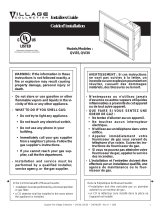Page is loading ...

© 2013 UTC Fire & Security. All rights reserved. 1 / 4 P/N 3101076 • REV 04 • REB 24JAN13
IB4U Analog Isolator Detector Base
Installation Sheet
EN FR
EN: Installation Sheet
Operation
The IB4U Analog Isolator Detector Base is used to protect a
Class A SLC from total collapse due to wire-to-wire short
circuits. This is accomplished by isolating the part of the loop
containing the short from the remainder of the circuit. When the
cause of the short circuit is corrected, restore the loop by
resetting the control panel.
The base does not require a separate address because it
shares the address of the device it is connected to.
Installation
Cautions
• To avoid accidental damage to the panel, disconnect all
power before wiring the unit.
• Electrical supervision requires the wire run to be broken at
each terminal. Do not loop the signaling circuit field wires
around the terminals.
To install the base:
1. Install a compatible electrical box, and then pull all wiring
into the box.
2. Make all wiring connections as shown in “Wiring” below.
3. Attach the base plate to the electrical box using the
screws provided with the electrical box.
4. Attach the trim ring to the base plate. Align the marks on
the trim ring and base plate, press the trim ring onto the
base plate, and the rotate the trim ring until it locks into
place.
5. Attach the desired detector to the base. Align the arrows
on the detector and trim ring, press the detector into the
base, and then rotate the detector until it locks into place.
6. Apply power and activate the unit to verify that it is
operating properly.
Figure 1: Base installation
1. Detector
2.
Trim ring
3. Screw
4. Base plate
5. Compatible electrical box
Wiring
Wire in accordance with NFPA 72 and CAN/ULC-S524. Be
sure to observe the polarity of the terminals on the terminal
block as shown in the diagram.
Break the wire run at each terminal. Do not loop signaling
circuit field wires around terminals.
Note: Shielded wire is required only in environments with very
high electrical noise. When you use shielded cable, follow
these recommendations:
• Shield connection to and from the base must be
continuous and must be insulated from ground. Insulate
the shield using tape.
• For Class B wiring, there is no shield connection to ground
at the last device.

4 / 4 P/N 3101076 • REV 04 • REB 24JAN13
/



